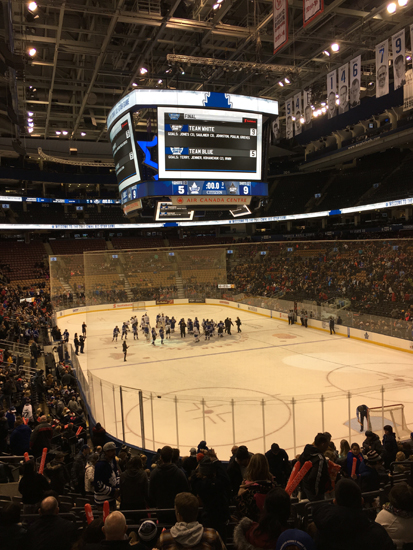
Their faces suddenly lit up. One of the cameras in the arena caught them cheering and dancing all in a row. And there they were jumping up and down in unison to the sound of a Spice Girls pop tune. They were thrilled to be up on the jumbo screen at the Air Canada Centre. But most of all they loved showing off their team jerseys, the North Durham Blades hockey team. And the camera cut to a makeshift placard another young female hockey player was holding.
“Play like a girl!” it proclaimed proudly.

It was about midway through the third period during the Canadian Women’s Hockey League All-Star game last Saturday afternoon at the ACC. The game between the White and Blue All-Stars had turned into more of a romp than fierce competition. As with many all-star games – to avoid injuries – there wasn’t much serious checking, very few slap shots, and the goalies were left pretty much at the mercy of two powerful offensive teams.
All the professional women players, from teams such as the Brampton Thunder, Boston Blades, Calgary Inferno, Les Canadiennes de Montréal and Toronto Furies, were scattered across the rosters of both the Blue and White teams.
With the score something like 7-4, and The Sports Network going to a commercial break, the jumbo scoreboard screen inside the ACC virtually exploded with images and a throbbing soundtrack. The cameras caught one of the coaches, I think it was Tessa Bonhomme, former Olympic gold medalist with the Canadian national women’s hockey team, pro player with the Toronto Furies and TSN broadcaster.
Seeing herself on camera, and as coach of Team White, she started dancing behind the bench. Then, she got the entire team on bench up and dancing. The game had morphed into an exhibition of breakneck-speed skating, tic-tac-toe passing, and female pride in their game.

I was there with my adult daughter, she wearing one of her Team Canada sweaters from times past, I wearing my fleece sweater with my oldtimers hockey club logo on it. But I was clearly outnumbered by the women in the bleachers and overwhelmed by the enthusiasm for women’s hockey all around me.
In fact, during one of the intermissions, I wandered through one of the gift shops where fans perused the merchandise, dominated by Leafs and Raptors jerseys, hoodies, caps and toques. I overheard one of the teenage customers talking to a clerk.
“Where’s the Toronto Furies stuff?” she asked. “I want a Carlee Campbell shirt.” And it was there, all right, just tucked in behind all the Auston Matthews and Mitch Marner merchandise.
Back in the 1990s, I went looking for the roots of women’s hockey. I learned while Lord Stanley of Preston, Canada’s sixth governor general, had a cup named after him for presentation to the best amateur hockey team in Canada, that he never played the game. His family, however, loved it, including his daughter Isobel, captured in an historic photo on an ice pad at Rideau Hall in 1890.
In the new century, women’s teams – often playing in long skirts and cloches – flourished in Ottawa, the Maritimes, the Prairies and even in Dawson City. University women’s hockey took off before the Great War. In the 1930s, teams with such dazzling names as “The Rivulettes,” “The Rustlers” and “The Crystal Sisters” competed for the Lady Bessborough Trophy; one Toronto Star headline described their hockey this way:
“Sticks and Fists Fly Freely as Girl Hockeyists Battle,” it said in March of 1935.
Other milestones included: the first play-by-play broadcast of a women’s hockey game on CJRB in Boissevain, Manitoba, in 1975; the first world women’s hockey tournament offering the Hazel McCallion (former Mississauga mayor) Cup in 1987; in 1990, the first International Ice Hockey Federation women’s championship; the birth of the Canadian Women’s Hockey League in 2007, and the Clarkson Cup two years later for the top Canadian women’s club.
Back in the 1990s, I asked Fran Rider, then the playing president of the Ontario Women’s Hockey Association, to define their game.

“There’s something very special about female hockey,” she told me. “During the game we compete. After the game we co-operate. Together we have won. As a team, we have won credibility for female hockey and the opportunity to be part of the … Olympics.”
Since the inauguration of women’s hockey at the Winter Olympics, in Nagano, Japan, Canadian women’s teams have chalked up a silver and four straight golds. I for one will never forget the comeback win at Sochi in 2014. With less than a minute left in the gold-medal game, Marie-Philip Poulin gave Canada a tie against Team U.S.A., and then scored in overtime to capture gold.
If Oxford ever needed a definition of grit, Canada’s women’s hockey team that year was it. And yet, equally important, Tessa Bonhomme told Canadian Living, is the objective of having fun.
“Take a lot of pictures when you’re at tournaments,” Bonhomme advises young women hockey players, “and make as many friends as possible.”